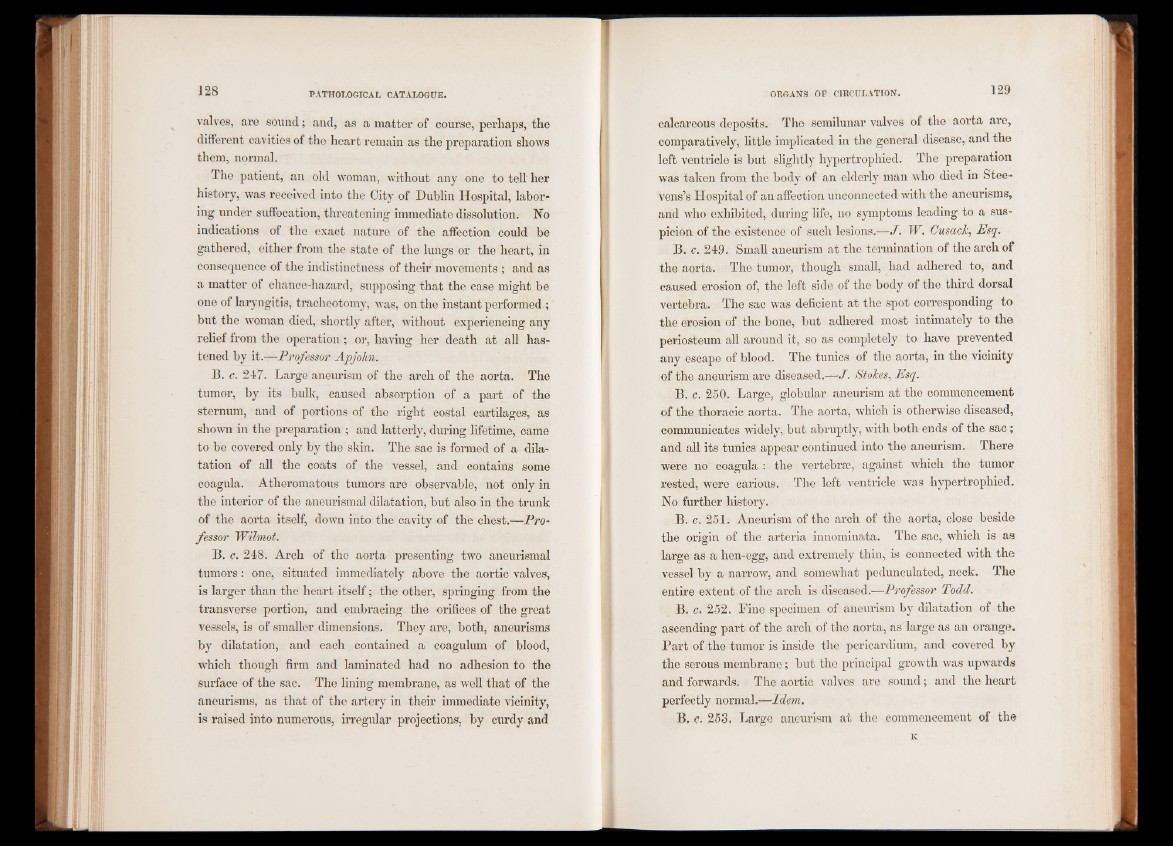
valves, are sound; and, as a matter of course, perhaps, the
different cavities of the heart remain as the preparation shows
them, normal.
The patient, an old woman, without any one to tell her
history, was received into the City of Dublin Hospital, laboring
under suffocation, threatening immediate dissolution. No
indications of the exact nature of the affection could be
gathered, either from the state of the lungs or the heart, in
consequence of the indistinctness of their movements ; and as
a matter of chance-hazard, supposing that the case might be
one of laryngitis, tracheotomy, was, on the instant performed.;
but the woman died, shortly after, without experiencing any
relief from the operation; or, having her death at all hastened
by it.—Professor Apjolm.
B. c. 247. Large aneurism of the arch of the aorta. The
tumor, by its bulk, caused absorption of a part of the
sternum, and of portions of the right costal cartilages, as
shown in the preparation ; and latterly, during lifetime, came
to be covered only by the skin. The sac is formed of a dilatation
of all the coats of the vessel, and contains some
coagula. Atheromatous tumors are observable, not only in
the interior of the aneurismal dilatation, but also in the trunk
of the aorta itself, down into the cavity of the chest.—Professor
Wil/mot.
B. c. 248. Arch of the aorta presenting two aneurismal
tumors: one, situated immediately above the aortic valves,
is larger than the heart itself; the other, springing from the
transverse portion, and embracing the orifices of the great
vessels, is of smaller dimensions. They are, both, aneurisms
by dilatation, and each contained a coagulum of blood,
which though firm and laminated had no adhesion to the
surface of the sac. The lining membrane, as well that of the
aneurisms, as that of the artery in their immediate vicinity,
is raised into numerous, irregular projections, by curdy and
calcareous deposits. The semilunar valves of the aorta are,
comparatively, little implicated in the general disease, and the
left ventricle is but slightly hypertrophied. The preparation
was taken from the body of an elderly man who died in Stee-
vens’s Hospital of an affection unconnected with the aneurisms,
and who exhibited, during life, no symptoms leading to a suspicion
of the existence of such lesions.—J. W. Cusack, Esq.
B. c. 249. Small aneurism at the teimination of the arch of
the aorta. The tumor, though small, had adhered to, and
caused erosion of, the left side of the body of the third dorsal
vertebra. The sac was deficient at the spot corresponding to
the erosion of the bone, but adhered most intimately to the
periosteum all around it, so as completely to have prevented
any escape of blood. The tunics of the aorta, in the vicinity
of the aneurism are diseased.—J. Stokes, Esq.
B. c. 250. Large, globular aneurism at the commencement
of the thoracic aorta. The aorta, which is otherwise diseased,
communicates widely, but abruptly, with both ends of the sac;
and all its tunics appear continued into the aneurism. There
were no coagula : the vertebrae, against which the tumor
rested, were carious. The left ventricle was hypertrophied.
No further history.
B. c. 251. Aneurism of the arch of the aorta, close beside
the origin of the arteria innominata. The sac, which is as
large as a hen-egg, and extremely thin, is connected with the
vessel by a narrow, and somewhat pedunculated, neck. The
entire extent of the arch is diseased.—Professor Todd.
B. c. 252. Fine specimen of aneurism by dilatation of the
ascending part of the arch of the aorta, as large as an orange.
Part of the tumor is inside the pericardium, and covered by
the serous membrane; but the principal growth was upwards
and forwards. The aortic valves are sound; and the heart
perfectly normal.—Idem.
B. c. 253, Large aneurism at the commencement of the
K